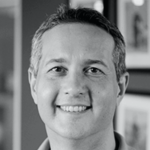
The world is waking up to what we have known for years: heart disease and chronic anxiety and depression are linked. That’s according to a January 2021 report from the American Heart Association.
When Do Random Facts Become a Pattern?
Throughout 2021, data on the connection between chronic health problems and behavioral health have trickled out of the research community, including these two items in December:
- A December 2021 study from the University of Denmark found the risk of developing Type 2 diabetes is higher among people diagnosed with mental illness. Roughly 9% of the global population has type-2 diabetes, but 14% of those who suffer from anxiety and 40% of those who suffer from sleeping disorders also have the condition, a 43% and 126% increase, respectively.
- Data from a December 2021 randomized controlled trial published in JAMA showed that women who engaged in mindfulness-based stress reduction were approximately 33% less likely to have a low birth weight pregnancy than women who had traditional preventive care alone.
These are all facts from unrelated studies that highlight the connection between the mind and the body.
Drops In the Ocean
The importance of the mind-body connection is nothing new. The research above is all insightful in its own way, but its primary relevance in the world at large is that it puts more bricks in the great wall of data and makes this single point: the most effective way to treat the world’s most costly physical health problems includes treatment for mental health.
The total cost of chronic health condition management in the U.S. for 2020, inclusive of direct and indirect healthcare spending on mostly preventable illnesses that could be greatly reduced through behavior change, is roughly $3.7 trillion each year, or 20% of gross domestic product.
We all know these numbers. We even know the solutions.
What we don’t yet know is how to provide a care delivery model that addresses how to treat these problems, in an effective way, at scale.
This is the premise under which we launched Twill nearly a decade ago. My co-founder and I, who spent our early careers in technology building highly-engaging video games, thought we could infuse our gaming platforms with positive psychology, cognitive behavioral therapy (CBT), and mindfulness activities to make people healthier.
Today, the technology we deploy combines everything we learned about gamification with artificial intelligence (AI) and evidence-based medicine into a personalized, digital experience distributed via partnerships across the healthcare ecosystem including enterprises, health plans, health systems, and pharma and medical device manufacturers.
Globally, we reach more than 20 million lives and support a dozen chronic conditions in 10 languages. The composite technology components we’ve built enable us to configure personalized digital care solutions and deliver them at scale inside any partner’s healthcare cloud.
The mission we undertook 10 years ago is the one that still drives us today, and 2021 was a banner year for our organization.
Looking Back On 2021
Localization, activation and engagement are all terms we use internally at Twill to define the way we optimize the utilization of our product.
Twill Products: Efficacy, Engagement & Localization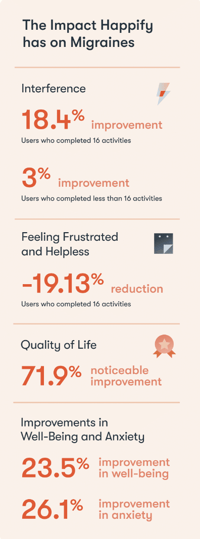
We’ve published data in the past about the efficacy of our products in randomized controlled trials. One of the key findings from the randomized controlled trials is that our digital therapeutics have demonstrated the ability to reduce anxiety and depression by 25%—twice as effectively as a psychoeducation program we used as a digital placebo.
In 2021, we published positive results from a pilot study of 5,000 migraine sufferers who used our digital therapeutics, and the results were exceptional. Patients involved in the migraine study reported the following:
- An 18% improvement in stress reduction
- An 18% reduction in migraine frequency
- A 72% improvement in their quality of life
Expect more news like this from our research team in 2022.
For the first time in 2021, in a series of speaking opportunities, we also shared data about the engagement rates on our platform following pilot studies with pharmaceutical partners. The data showed that our 60-day retention rates were nearly five times better (64%) than the average retention rates for financial services and news apps (13%), and four times better than traditional healthcare apps (4%).

As a global company, localization is critical to the success of our products. The process of making our products relatable to people from different communities with different backgrounds and cultures is essential to achieving high engagement rates.
To that end, one of our first big milestones in 2021 was the expansion of our localization capabilities into two additional languages, bringing the total to 10: English, French, Canadian French, Chinese, Japanese, Castilian Spanish, Latin-American Spanish, German, Brazilian Portuguese, and Italian.
New Product Launches
Perhaps the most exciting development at Twill was that we launched two new products in 2021.
The first was Ensemble, the first and only transdiagnostic digital therapeutic available anywhere in the world.
Launched in late July, Ensemble was designed as an adjunct to care for major depressive disorder (MDD) and generalized anxiety disorder (GAD). Clinicians can prescribe it to patients to treat these disorders via a smartphone or computer. 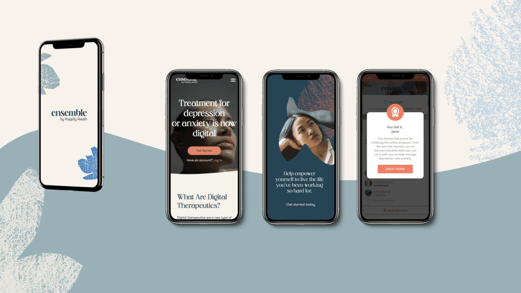
Then in August, we launched an expansion of our Twill Care product
to deliver community-based, digital support for 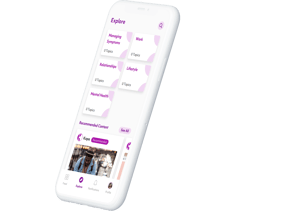 women's health, focusing on perimenopause and menopause transitions. Twill Care provides a unique way to deliver lifecycle marketing, peer-to-peer connection, and clinical expertise in a single, highly- engaging, online community staffed by healthcare professionals.
women's health, focusing on perimenopause and menopause transitions. Twill Care provides a unique way to deliver lifecycle marketing, peer-to-peer connection, and clinical expertise in a single, highly- engaging, online community staffed by healthcare professionals.
Twill Care was already rated as the #1 app in the U.S. for people with psoriasis, and our ability to expand and scale to new verticals creates wonderful new opportunities for Twill and our partners.
Research & Award-Winning Technology
Our company also won several awards in 2021. I won’t name them all here, but several should be called out.
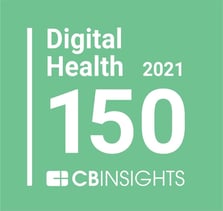 First, for the second year in a row, we were included in CB Insights 150 from a pool of over 11,000 digital health start-up companies. The cohort that we are a part of raised $14.9 billion in funding across more than 500 deals in the last five years. It’s a competitive group, and we were honored to be a part of it.
First, for the second year in a row, we were included in CB Insights 150 from a pool of over 11,000 digital health start-up companies. The cohort that we are a part of raised $14.9 billion in funding across more than 500 deals in the last five years. It’s a competitive group, and we were honored to be a part of it.
The second big award we won was a MedTech Visionaries award for Twill Care, our patient-centric care delivery and community engagement tool. In the field of psychology for people with chronic conditions, Twill Care stood out for its ability to engage patients in community care delivery platforms and keep them engaged.
Other awards and recognition included:
- “Top-rated mental health apps for COVID-19” (Science Direct)
- “Best Self-Improvement App for 2021” (BestApps.com)
- “Best Self-Care App for 2021” (Parade)
- “Best Mental Health App of 2021”(Verywell Mind)
Five Exciting New Partnerships
Early in 2021, Almirall shared the news that we’d entered into a strategic partnership to develop evidence-supported digital therapeutics solutions for people with psoriasis. Over the summer and into the fall, we began announcing a series of new partnerships that dramatically expanded our global reach.
Specifically, we announced distribution partnerships with Higi, the National Psoriasis Foundation (NPF) and Copado, as well as plans to distribute our products through Microsoft Azure.
Our partnership with Higi makes it possible for us to deliver personalized digital care through their substantial retail distribution network of over 10,000 Smart Health Stations. After announcing our partnership with Higi, we shared the news that the NPF had selected Twill Care to serve as the official online community for their members, making Twill Care an official, integrated part of the digital healthcare journey for people living with psoriasis.
In September, we announced our decision to distribute our products through Microsoft Azure because Microsoft enables us to integrate into the systems of record for provider groups and payers, giving us global reach in a fully-compliant and secure environment. It also enables partners like Higi to plug our AI and digital therapeutics into their connected patient ecosystem.
In November, we announced our partnership with Copado to accelerate product distribution globally within the Salesforce, Microsoft, and Veeva ecosystems. Copado helps us accelerate key points of technical integration for our business, like advanced data interoperability, payer-to-payer data exchange, and multi-cloud and consent governance capabilities.
Financing and Talent
Changing the face of healthcare requires teamwork, talent, and capital.
In March, we announced the completion of a $73M capital raise led by Deerfield Management Company, with contributions from Omega Capital Partners, ION Crossover Partners, and existing investors.
The money we raised funded the expansion of our digital therapeutics and care delivery platforms, as well as partnerships to expedite our global business development and distribution efforts.
The funding also helped us bring senior talent onto the team, including Goldman Sachs technology banker Bilal Khan as our Chief Financial Officer; Andy Palan, former CTO at CVS/Health, Intarcia Therapeutics and AdaptHealth, as Chief Information Officer; and Megan Callahan, former president and general manager of Lyft Healthcare, Inc., who also previously served as chief strategy officer for Change Healthcare, and SVP of corporate strategy and business development for McKesson.
 These three new leaders bring a level of talent and expertise to our executive team that will help us accelerate our growth.
These three new leaders bring a level of talent and expertise to our executive team that will help us accelerate our growth.
In addition to adding new talent, we also promoted key leaders within the organization. Chris Wasden, who runs our pharmacy business, was promoted to Head of Pharma Specialty Solutions and Corporate Strategy, and Keren Zimmerman, who led the development of our Twill Care platform, was promoted to Chief Product Officer.
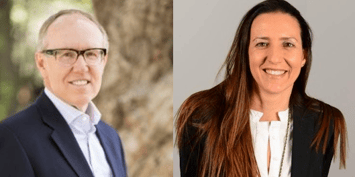 Overall in 2021, we tripled our staff to support the next phase of our growth. I’m constantly impressed with the level of talent and commitment to our vision that I see among those joining our company every week. It’s awe-inspiring to see what our teams are achieving together.
Overall in 2021, we tripled our staff to support the next phase of our growth. I’m constantly impressed with the level of talent and commitment to our vision that I see among those joining our company every week. It’s awe-inspiring to see what our teams are achieving together.
Looking Ahead
At the beginning of this article, I shared snippets of new research about the impact of behavioral healthcare on cardiovascular disease, healthy pregnancies, and migraines.
These are all tiny pieces of a larger mosaic of data that points to a fragmented healthcare system that has thousands of point solutions to address specific needs but in no way ties them together into a seamless, personalized experience that makes people healthier.
What we’re creating at Twill is something the market has never seen before: an Intelligent Healing Platform™ with the ability to make this seamless, personalized experience a reality.
Technology Meets Empathy
Heading into year three of the COVID-19 pandemic, the gaps between need and care has never been wider or more pronounced. At Twill, our technology will help the world close these gaps.
As 2021 comes to a close, I’m humbled and honored to say that Twill helps more than 20 million people around the world, across all seven continents, and in 10 different languages.
Our ability to help so many people is due to the fact that we’ve assembled and grown our team by more than 150 talented people. That team has helped us grow our business through a series of new partnerships that have more than tripled our top-line revenue growth.
This tremendous growth and infusion of talent has enabled us to create new technology that infuses artificial intelligence (AI) with empathy to deliver personalized, precise, and connected healthcare experiences that help people live happier, healthier, and more fulfilling lives.
To the team at Twill and to all of the partners, thank you for an amazing 2021.
Sincerely,
Tomer Ben-Kiki, Co-Founder and CEO, Twill
About the Author
Tomer Ben-Kiki Tomer is an experienced entrepreneur who has held the top leadership position at several companies, successfully steering them from inception through rapid growth. Previously, Tomer was the Co-Founder and CEO of Oberon Media, a leading casual gaming company providing for some of the world’s biggest brands, including Microsoft, Yahoo and Sprint. Prior to Oberon, Tomer was the Co-Founder and President of RichFx, an e-commerce startup that provided visual merchandising technologies to top retailers. He graduated cum laude from Tel Aviv University with a B.Sc. in Computer Science, and served as an IDF officer for seven years.

